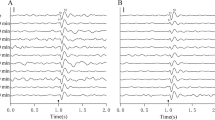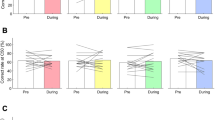Abstract
Reduced visual performance under transcranial magnetic stimulation (TMS) of human visual cortex demonstrates suppression whose spatial extent is not directly visible. We created an artificial scotoma (region missing from a visual pattern) to directly visualize the location, size and shape of the TMS-induced suppression by following a large-field, patterned, visual stimulus with a magnetic pulse. The scotoma shifted with coil position according to known topography of visual cortex. Visual suppression resulted in pattern-dependent distortion, and the scotoma was filled in with temporally adjacent stimuli, suggesting spatial and temporal completion mechanisms. Thus, perceptual measurements of TMS-induced suppression may provide information about cortical processing via neuronal connections and temporal interactions of neural signals.
This is a preview of subscription content, access via your institution
Access options
Subscribe to this journal
Receive 12 print issues and online access
$209.00 per year
only $17.42 per issue
Buy this article
- Purchase on Springer Link
- Instant access to full article PDF
Prices may be subject to local taxes which are calculated during checkout





Similar content being viewed by others
References
Barker, A. T., Jalinous, R. & Freeston, I. L. Noninvasive magnetic stimulation of human motor cortex. Lancet 1, 1106–1107 (1985).
Amassian, V. E. et al. Suppression of visual perception by magnetic coil stimulation of human occipital cortex. Electroencephalogr. Clin. Neurophysiol. 74, 458–462 ( 1989).
Beckers, G. & Hömberg, V. Cerebral visual motion blindness: transitory akinetopia induced by transcranial magnetic stimulation of human area V5. Proc. R. Soc. Lond. B Biol Sci. 249, 173–178 (1992).
Epstein, C. M., Verson, R. & Zangaladze, A. Magnetic coil suppression of visual perception at an extracalcarine site. J. Clin. Neurophyisiol. 13, 247–252 (1996).
Meyer, B.U., Diehl, R., Steinmetz, H., Britton, T. C. & Benecke, R. Magnetic stimuli applied over motor and visual cortex: Influence of coil position and field polarity on motor responses, phosphenes, and eye movements. Electroencephalogr. Clin. Neurophysiol. Suppl. 43, 121–134 ( 1991).
Marg, E. & Rudiak, D. Phosphenes induced by magnetic stimulation over the occipital brain: description and probable site of stimulation. Optom. Vis. Sci. 71, 301–311 (1994).
Kastner, S., Demmer, I. & Ziemann, U. Transient visual field defects induced by transcranial magnetic stimulation over human occipital pole. Exp. Brain Res. 118, 19–26 ( 1998).
Horton, J. C. & Hoyt, W. F. Quadrantic visual field defects. A hallmark of lesions in extrastriate (V2/V3) cortex. Brain 114, 1703–1718 (1991).
Sereno, M. I. et al. Borders of multiple visual areas in humans revealed by functional magnetic resonance imaging. Science 268, 889–893 (1995).
DeYoe, E. A. et al. Mapping striate and extrastriate visual areas in human cerebral cortex. Proc. Natl. Acad. Sci. USA 93, 2382 –2386 (1996).
Jones, J. P. & Palmer, L. A. An evaluation of the two dimensional Gabor filter model of simple receptive fields in cats striate cortex. J. Neurophysiol. 58, 1233–1258 (1987).
Gilbert, C. D., Hirsch, J. A. & Wiesel, T. N. Lateral interactions in visual cortex. Cold Spring Harb. Symp. Quant. Biol. 55, 663– 677 (1990).
Kapadia, M. K., Ito, M., Gilbert, C. D. & Westheimer, G. Improvement in visual sensitivity by changes in local context: parallel studies in human observers and in V1 of alert monkeys. Neuron 15, 843–856 (1995).
Polat, U., Mizobe, K., Pettet, M. W., Kasamatsu, T. & Norcia, A. M. Collinear stimuli regulate visual responses depending on cell's contrast threshold. Nature 391, 580–584 (1998).
Polat, U. & Sagi, D. Lateral interaction between spatial channels: suppression and facilitation revealed by lateral masking experiments. Vision Res. 33, 993–999 (1993).
Weisstein, N. in Handbook of Sensory Physiology VII/4: Visual Psychophysics (eds. Jameson, D. & Hurvich, L. M.) 233–272 (Springer, Berlin, 1971).
Breitmeyer, B. G. Visual Masking: An Integrative Approach (Oxford Univ. Press, Oxford, 1984).
Amassian, V. E. et al. Unmasking human visual perception with the magnetic coil and its relation to hemispheric asymmetry. Brain Res. 605 , 312–316 (1993).
Kammer, T. & Nusseck, H. Are recognition deficits following occipital lobe TMS explained by raised detection thresholds? Neuropsychologia 36, 1161–1166 ( 1998).
Amassian, V. E. et al. The polarity of the induced electric field influences magnetic coil inhibition of human visual cortex: implications for the site of excitation. Electroencephalogr. Clin. Neurophysiol. 93, 21–26 (1994).
Stensaas, S. S., Eddington, D. K. & Dobelle, W. H. The topography and variability of the primary visual cortex in man. J. Neurosurg. 40, 747– 755 (1974).
Acknowledgements
We thank Y. Ugawa, Y. Terao and R. Hanajima for technical instruction in transcranial magnetic stimulation and M. Konishi, C. Koch, B. Sheth and J. Weber for comments on the manuscript. We also thank I. Fujita and Y. Takahashi for discussions. Supported by Caltech Engineering Research Center NSF grant (#EEC-9402726).
Author information
Authors and Affiliations
Corresponding author
Rights and permissions
About this article
Cite this article
Kamitani, Y., Shimojo, S. Manifestation of scotomas created by transcranial magnetic stimulation of human visual cortex. Nat Neurosci 2, 767–771 (1999). https://doi.org/10.1038/11245
Received:
Accepted:
Issue Date:
DOI: https://doi.org/10.1038/11245
This article is cited by
-
rTMS over the human medial parietal cortex impairs online reaching corrections
Brain Structure and Function (2023)
-
Dancing Chief in the Brain or Consciousness as an Entanglement
Foundations of Science (2020)
-
Retinal and visual cortex distance from transcranial magnetic stimulation of the vertex affects phosphene perception
Experimental Brain Research (2017)
-
Shining new light on dark percepts: visual sensations induced by TMS
Experimental Brain Research (2015)
-
TMS stimulation over the inferior parietal cortex disrupts prospective sense of agency
Brain Structure and Function (2015)



